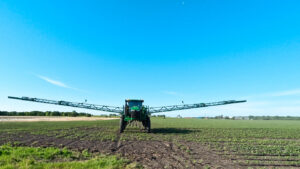Tech-enabled farming is taking hold in rural Australia, creating an opening for more sustainable farming. A recent study by the National Australia Bank (NAB), Backing Rural Australia – Future-proofing our farmers through sustainability and AgTech solutions, detailed how the farmers it finances use agtech and think about risk management.
The report evaluated how farmers use eight agtech tools: farm management accounting software, automation, digital markets and supply chains, yield mapping, climate soil sensors, imaging, livestock sensors and biometrics, and predictive decision support software. Additionally, the NAB sought to understand the challenges farmers face in adopting new technologies, identify the primary environmental risks that farmers face, and evaluate how agtech could assist farmers in running more sustainable businesses.
Surveying the Field
Of the 739 farmers interviewed, 25% use no agtech. On average, farmers used between two and three of the eight technologies the report evaluated.
Farm management accounting software and automation were the most commonly used on average, with 51% of all respondents adopting accounting software and 37% using some form of automation. 43% of livestock farmers employed sensor and biometric technology.
Horticultural producers use automation and climate soil sensors more than any other kind of farmer and row crop producers use spot sensor technology to reduce chemical use and led the pack among users of yield mapping and field imaging.
The farmers interviewed identified soil health, water scarcity, and energy costs as their primary risks and concerns. Agrichemical run-off, managing waste, biodiversity, and greenhouse gas emissions were less critical concerns for farmers. The NAB report suggests that agtech tools like spot sensor technology, automated processes, yield mapping, and more could help farmers manage their farms to reduce risk, but also to operate more sustainably.
Challenges in Implementation
Agtech startups often report struggles to get farmers to adopt their technology in order to demonstrate the potential benefits of agtech tools, according to the report. For farmers, the upfront capital costs can be off-putting even if the efficiencies can be cost-effective in the long run, something crop farmer David Gooden knows first hand, as described in the report.
Gooden opted to invest in a WEEDit spot sprayer machine that identifies weeds and applies herbicide only where needed. Rather than covering an entire field, through the targeted approach he sprays 18% of his crop area, reducing his chemical use dramatically. But he realizes the capital investment turns many farmers away.
“Farmers have to be certain of a return on investment,” Gooden said in the report. “There have to be rewards along the way. If it’s too complicated or doesn’t meet expectations, it just sits in a corner and is a cost.”
Connectivity also remains a roadblock to adoption for many Australian farmers—simply not having reliable access to the Internet inhibits their ability to use many of the available tools. In an effort to remedy this, WI-SKY, an Internet infrastructure company, is building its own towers in rural communities rather than wait for federal efforts to expand access. The company, which receives support from the NAB, is working with farmers to make it easier for them to incorporate agtech into their business practices.
Value Beyond Earnings
The report focuses on an idea of ‘natural capital,’ which the authors define as the value of factors like soil health and biodiversity. Agtech — through tools like spot sensors to reduce chemical use — the report proposes, has a role to play in encouraging farmers, innovators, and investors to consider that the value of the farm is more than the value of the land or the product. Practices like pasture diversity, nutrient recycling, and maintaining habitats for pollinators and pest predators are a critical factor in managing risk for farmers and in developing a sustainable business model.
“To ensure a long-term viable industry, [farmers] need to look after their soil and use their water and energy in smart ways,” said Garry Gale, NAB head of agribusiness development, in the report. Investment in agtech, the report suggests, can encourage the industry to think about ecological management of natural capital as a business opportunity and in so doing develop more sustainable agriculture.




